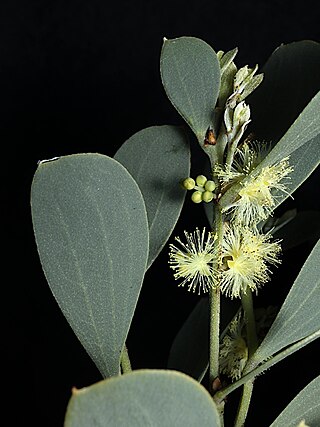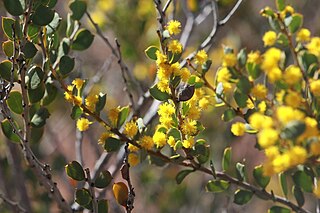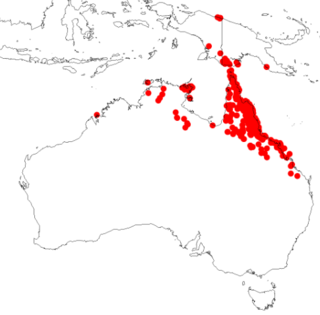
Acacia acanthoclada, commonly known as harrow wattle, is a species of flowering plant in the family Fabaceae and is endemic to southern continental Australia. It is a low, highly branched, spreading and spiny shrub with wedge-shaped to triangular or egg-shaped phyllodes with the narrower end towards the base, and spherical heads of up to 30 flowers, and linear, spirally-coiled pods.

Acacia alpina, commonly known as alpine wattle is a species of flowering plant in the family Fabaceae and is endemic to alpine and subalpine regions of south-eastern continental Australia. It is an erect or spreading shrub or tree with egg-shaped or broadly egg-shaped phyllodes with the narrower end towards the base, flowers arranged in 1 or 2 racemes in the axils of phyllodes, each with cylindrical to oblong, usually pale yellow flowers, and thin-walled, gently curved or coiled pods 30–80 mm (1.2–3.1 in) long.

Acacia complanata, known as long-pod wattle and flat-stemmed wattle, is a perennial tree native to eastern Australia.

Acacia acinacea, commonly known as gold dust wattle, wreath wattle or round-leaf wattle. is a species of flowering plant in the family Fabaceae and is endemic to south-eastern continental Australia. It is a bushy or straggling shrub with asymmetric, narrowly oblong to broadly egg-shaped phyllodes with the narrower end towards the base, flowers arranged in a spherical heads 4.0–4.5 mm (0.16–0.18 in) in diameter with 8 to 20 flowers, and a spirally coiled to twisted pods up to 3.0–4.5 mm (0.12–0.18 in) long.

Acacia gunnii, commonly known as ploughshare wattle or dog's tooth wattle, is a woody shrub which is endemic to south-eastern Australia found in dry heaths and woodlands. It ranges from Queensland, then New South Wales, Australian Capital Territory, Victoria, South Australia, down to Tasmania. Acacia gunnii grows to up to 1 metre high and has prickly phyllodes which are 4 to 15 mm long. The cream to pale yellow globular flowerheads appear singly in the axils of the phyllodes in June to October, followed by curved or coiled seed pods which are 40 mm long and 4 to 5 mm wide. Acacia gunnii grows up to 1 meter tall and has prickly phyllodes which are 4 to 15mm in length with cream to pale-yellow globular flower heads appearing in phyllode axils in June through to October, followed by curved or coiled seed pods which are 40mm long and 4 to 5 mm wide. The species was first formally described by English botanist George Bentham in the London Journal of Botany in 1842. It occurs in South Australia, Victoria, Tasmania, New South Wales, Australian Capital Territory, and Queensland.

Acacia flexifolia, commonly known as bent-leaf wattle or small winter wattle, is a shrub species that is endemic to eastern Australia.

Acacia leptocarpa, commonly known as north coast wattle, is a shrub or small tree native to New Guinea and coastal regions of northern Australia.

Acacia hakeoides, known colloquially as hakea wattle, hakea-leaved wattle or western black wattle, is a species of flowering plant endemic to southern Australia. It is a bushy shrub or tree with lance-shaped to linear phyllodes, racemes of bright golden-yellow flowers and more or less leathery to leathery to hard and brittle pods. It can be found growing in sandy soils in semiarid and Eucalyptus woodland in the region.

Acacia incurva is a shrub belonging to the genus Acacia. It is native to the South West region of Western Australia.

Acacia acoma is a species of flowering plant in the family Fabaceae and is endemic to inland ares of south-western Western Australia. It is an erect, spindly, open or spreading shrub with variably-shaped, often narrowly oblong phyllodes, flowers arranged in spherical heads, usually arranged in pairs in leaf axils, and strongly curved or spirally coiled pods up to 15 mm (0.59 in) long when expanded.

Acacia acuaria is a species of flowering plant in the family Fabaceae and is endemic to the south-western of Western Australia. It is a rounded or diffuse to spreading, prickly shrub with sharply pointed, rigid, needle-shaped phyllodes, flowers arranged in more or less spherical heads of 14 to 23 flowers, and strongly curved or openly coiled pods up to 50 mm (2.0 in) long.

Acacia adinophylla is a species of flowering plant in the family Fabaceae and is endemic to a small area in the south-west of Western Australia. It is a prostrate to erect, scrambling shrub with cylindrical branchlets, narrowly wedge-shaped to lance-shaped phyllodes, flowers arranged in up to 4 spherical heads of dull golden yellow flowers, and paper-like pods.

Acacia bidentata is a shrub belonging to the genus Acacia and the subgenus Phyllodineae and is native to Western Australia.

Acacia erinacea, also known as prickly wattle, is a shrub belonging to the genus Acacia and the subgenus Phyllodineae that is native to Western Australia.

Acacia adenogonia is a species of flowering plant in the family Fabaceae and is endemic to northern Western Australia. It is a prickly, erect to sprawling shrub with cylindrical branchlets, egg-shaped to lance-shaped phyllodes, flowers arranged in spherical heads of golden yellow flowers, and thin leathery pods that are constricted between the seeds.

Acacia simsii is a shrub belonging to the genus Acacia in the family Fabaceae. It is native to New Guinea and northern Australia. In Australia it is found in both the Northern Territory and Queensland.

Acacia aculeatissima, commonly known as thin-leaf wattle or snake wattle, is a species of flowering plant in the family Fabaceae and is endemic to south-eastern continental Australia. It is usually a prostrate shrub with sharply pointed, needle-shaped phyllodes, flowers arranged in up to 3 more or less spherical heads of 15 to 25 flowers, and linear, papery pods up to 60 mm (2.4 in) long.

Acacia brachybotrya, commonly known as grey mulga or grey wattle, is a shrub belonging to the genus Acacia and the subgenus Phyllodineae that is endemic to Australia.

Acacia conferta, commonly known as crowded-leaf wattle, is a shrub belonging to the genus Acacia and the subgenus Phyllodineae that is endemic to eastern Australia.

Acacia gladiiformis, commonly known as sword wattle or sword-leaf wattle, is a shrub belonging to the genus Acacia and the subgenus Phyllodineae that is native to parts of eastern Australia.






















